CHAPTER 8 - EXAMPLE MUSICAL ANALYSES
BRAHMS ST ANTONI CHORALE VARIATIONS
Step 3 - Identify the Functional Chord progressions
Now that we have identified the voice leading and motivic patterns, we can examine the underlying root progression patterns that have been revealed. The voice leading gave us the melodic structures; the root progression patterns give us the musical phrase structures that support the melody and form of the piece.
As is normally observed in tonal music, the root progression patterns show the typical segmentation into static harmony (prolongation of one chord) and dynamic harmony (chord movement) as explained below.
Phrase 1 (bars 1 to 5).
In the analytical outline, the voice leading patterns are summarised as black note heads and the underlying structural notes as white note heads. Please note, these symbols are not used to represent the length of the notes. Please also refer to the Glossary of Symbols for a full explanation of all symbols used. Bars 1 and 2, are shown as follows:
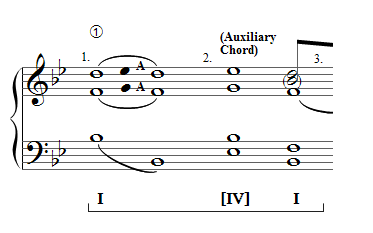
Slurs are used to show notes which are repeated or arpeggiated within the same structural chord. This helps to show the extent of a single structural chord. The auxiliary notes in bar 1 are consequently shown as black note heads annotated as "A".
The root progression pattern uncovered in these two bars is simply an oscillation of chord I to chord IV and back to chord I. These bars are static harmony using chord IV as the auxiliary chord. I - IV - I static harmony is typical of church music (whereas I - V- I is more commonly associated with secular music.) This contributes to the 'chorale' effect of the melody and is thus an indicator of the style of the music.
In this static harmony, the voice leading and oscillating (I - IV - I) root progression serves to prolong the tonic chord. There is no overall root movement. Static prolongation of the tonic chord is the most common way of starting a musical phrase as represented in the standard tonal musical phrase structure. For more on static harmony please refer to Chapter 2 Part 1: Static Harmony. See next section for a full analysis of the phrase structure.
Bars 3 - 4 are represented in the analytical outline as follows:
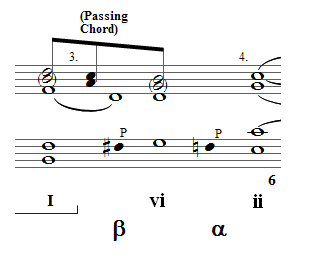
The passing chord (identified earlier) is shown as two black notes with a stem and a beam which shows how the passing notes fill in between notes of the structural chords: I and VI. This reveals a structural root progression in which the root rises a 6th (the same as a falling 3rd) from Bb to G. This is the start of a segment of dynamic harmony and the falling third progression is the second most common type of root progression in dynamic harmony. This is shown by the Greek letter β in the analytical outline.
Bars 4 to 5 are represented in the analytical outline as follows:
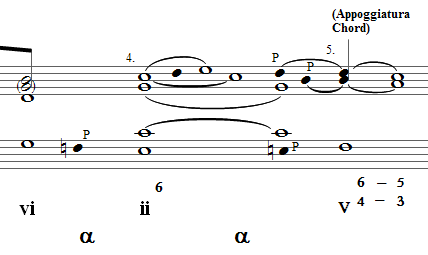
The dynamic harmony thus moves from chord VI to chord ii which is a rising 4th progression. This is indicated by the Greek letter α. This is the most common progression in dynamic harmony in tonal music. The F natural in the bass is a passing note connecting these two chords. As can be seen in the Piano Reduction and the Analytical Outline the fact that chord ii is in first inversion, accommodates this passing note. This is followed by a further rising fourth progression to chord V. As this is the end of the phrase, the phrase ends on an imperfect cadence in bar 5. The slurs and the figuration under the score show the voice leading movements that make up the appoggiaturas and their resolutions. For more on dynamic harmony please refer to Chapter 2 Part 2: Dynamic Harmony
Phrase 2 (bars 6 to 10).
By reference to the full analysis chart it can be seen that the harmonic progression is similar to the first phrase but with a full V - I cadence ending as indicated in the voice leading analysis above. The outline shows the appoggiaturas decorating both the V and the I of the cadence.

For further discussion of these appoggiaturas see the analysis of the voice leading in the previous section.
Phrase 3 (bars 11 to 18)
Phrase 3 is the B section of the formal structure. The root progression in bars 11 to 14 represents a prolongation of the dominant chord as established in the voice leading analysis in the previous section. This is represented in the analysis outline, as follows:
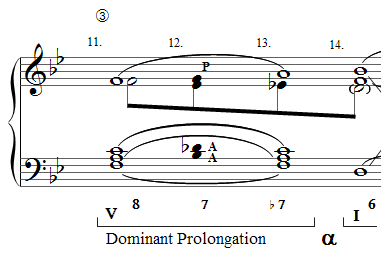
The white note heads show the structural notes. These are connected by slurs to show the arpeggiation in the top voice and the repeated structural notes in the lower voices. The passing note and the two auxiliary notes are shown as black note heads and the linear progression, which is made up of two successive passing notes ( E and Eb) is shown in the alto voice connected by stems and a beam. The structural starting and ending notes are shown by white note heads (F and D) and the intermediate non-structural passing notes by black note heads. This shows how the F of the dominant chord is connected to the D of the Bb chord by a step wise motion, as is always the case with linear progressions. As the D note is in the bass part, Brahms avoids doubling it in the middle voice, which is why it is not present there but it is nevertheless a note of the chord. This step by step motion works in counterpoint with the sustained dominant note in the bass and with the auxiliary and passing patterns in the other voices.
The dominant prolongation forms an important syntactic function in the phrase, which I will cover later. The dominant prolongation is followed by a rising 4th progression connecting this to the tonic chord in bar 14. The tonic chord is first present in first inversion, to avoid too strong a perfect cadence at a point which is not appropriate in the musical phrase. The tonic chord is prolonged, (albeit briefly) by the "voice exchange" mentioned in the voice leading analysis. This is shown in the analytical outline as follows:
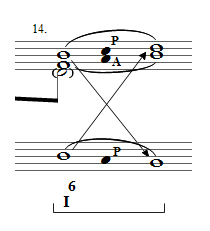
The arrows show how the Bb of the top voice is transferred to the bass and the D of the bass is transferred to the top voice.
A segment of dynamic harmony now follows from bars 14 to 18. This is represented in the analytical outline as follows:
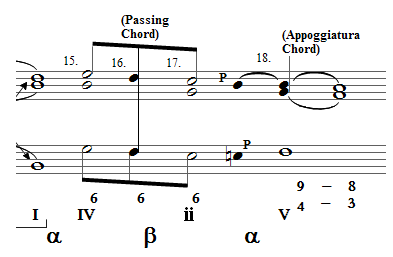
The underlying chord progression is a falling 3rd progression which is then followed by a rising 4th progression to the dominant chord in bar 18. The dominant chord is elaborated by appoggiaturas as at the end of phrase 1. This results in dynamic harmony made up of two rising 4th progressions followed by a descending 3rd progression followed by two further rising 4th progressions. This segment of dynamic harmony uses the same two root progressions as phrases 1 and 2 even thought the chords used are different. Hence the unity is supported by the selection of root movement in the dynamic harmony. This phrase, like the first phrase, ends on an imperfect cadence. The use of alpha and beta progressions is a characteristic of 19th century music whereas a combination of alpha and gamma progressions is more characteristic of 18th century classical tonality. The choice of chord progressions in dynamic harmony is thus an indicator of style of the music.
Phrase 4 (bars 19 to 30)
This phrase represents an extended variation of the main theme, shown as A'. The first 4 bars of the phrase (19 to 22) are identical to the first 4 bars of phrase 3 (bars 6 to 9), apart from the octave doubling which increases the intensity of the music towards the end of the movement. The cadential chord I in bar 23, however, rather than being elaborated by simple appoggiaturas as in bar 10, is extended by a new (I - IV - I) static harmony pattern as uncovered in the voice leading analysis above. This is represented in the analytical outline as follows:
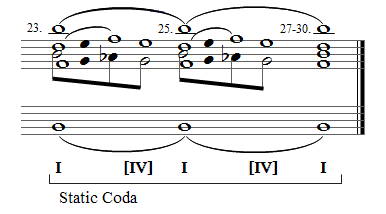
This is a further segment of static harmony appended to the end of the phrase as explained in the phrase analysis to follow.
Next Section - Phrase Syntax Analysis

